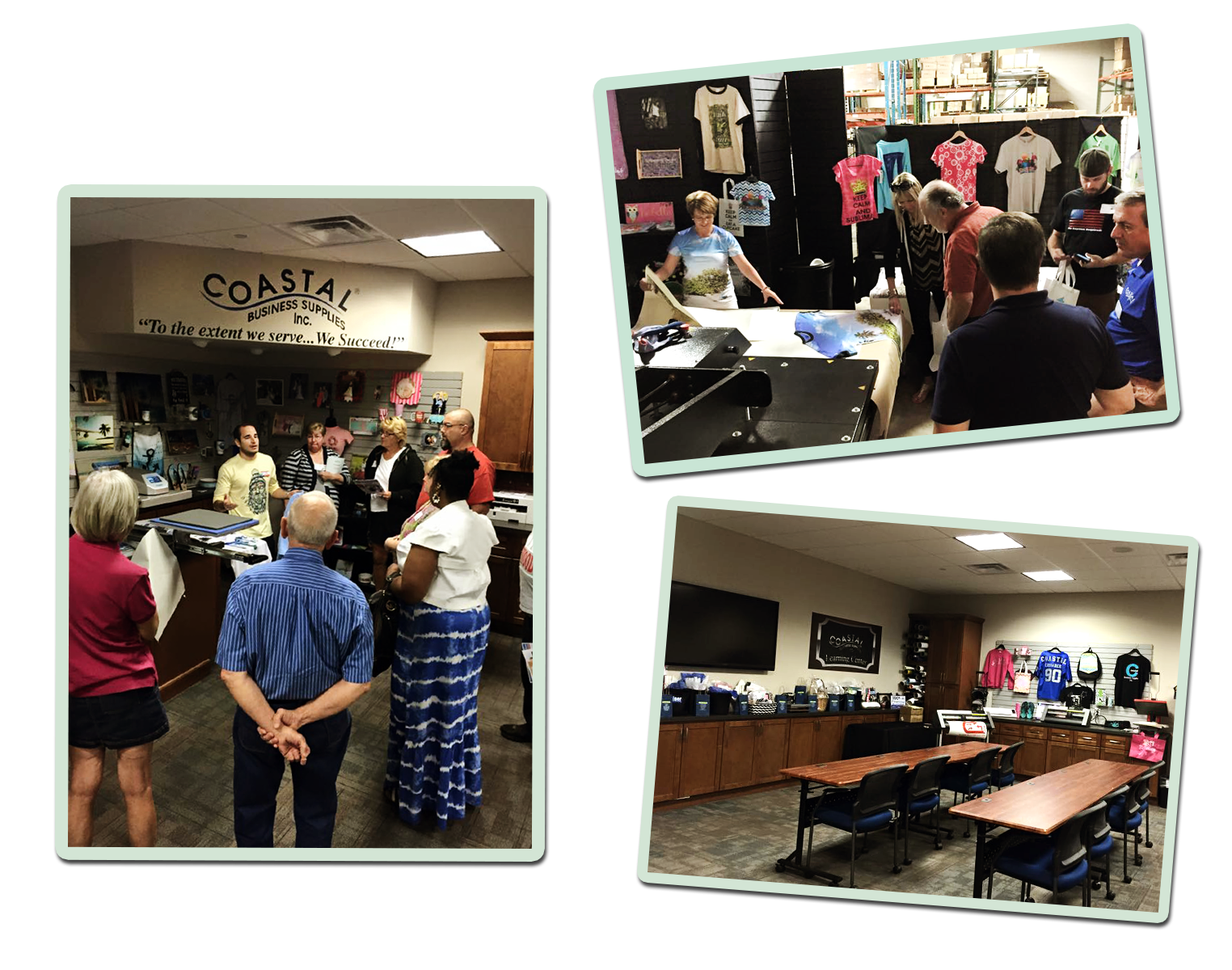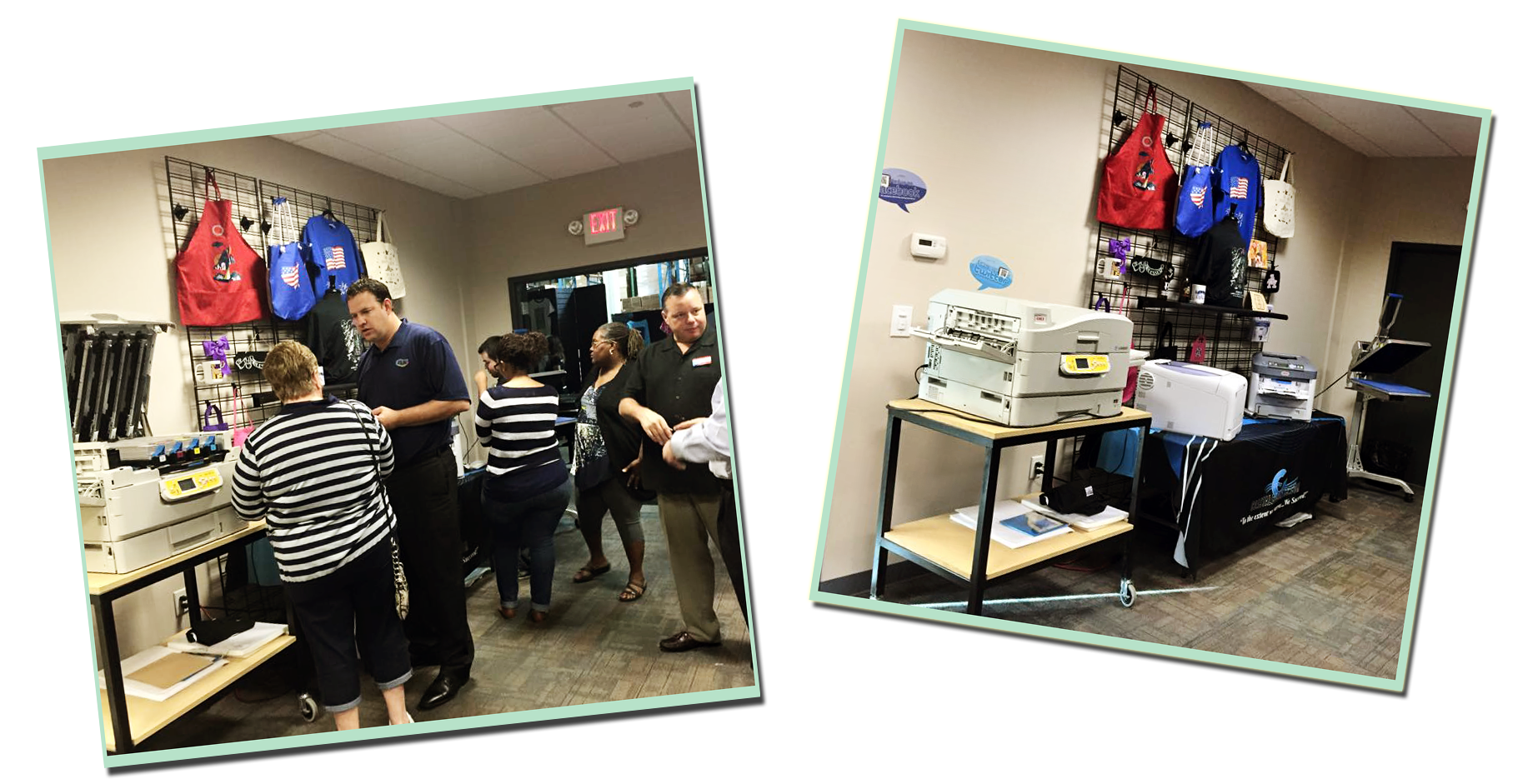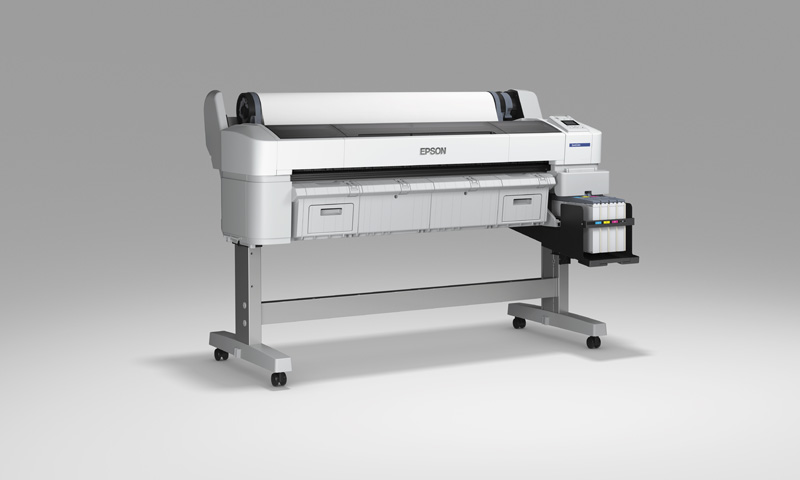On September 25th, 2015 Coastal Business Supplies hosted a very successful Open House with a fabulous turnout of customers and tremendous support from our vendor partners. Those partners included Siser, Graphtec, HIX, OKI Data, Neenah Paper, Unisub and Chromaluxe, Vapor Apparel, FDC, EPSON, Hotronix and ACG Finance! Thank you so very much to everyone who attended!
For those of you who were not able to attend the event, I wanted to give you a sense of what everyone was demonstrating and getting to see first hand.
First off, sublimation mobile cases are still alive and kicking! It might not be the massive game changer it was, but people are still decking their Samsung and iPhone devices with custom phone cases. The truly interesting part to me was that people who have actually traditionally been desktop sublimators are now looking at the EPSON F-Series solutions to save money on ink and increase production. The Unisub SwitchCase Grip device covers were also very popular, as well as the line of Chromaluxe photo panels and the new natural Chromaluxe wood panels.
Fun and fashionable Vapor Apparel socks and sleeves were created at the event by customers, as well as a wide variety of sublimation shirts. Prints were created on-site with all-over transfers printed from the new Epson F6200 and pressed on the Geo Knight Maxi 44” press, and also smaller transfers created with the Sawgrass Virtuoso printers and pressed on the Hotronix Fusion. We could hardly keep up with the demand for the Vapor products! This was a great firsthand way to see how these transfer processes are done and helped solve some problems of customers’ initial experiences by seeing the help of the right heat press accessories put to use, especially the “hows” and “whens” to use these products.
We also saw a huge amount of interest in the OKI Data heat transfer solutions, including both the CMYK C831TS and the white toner solutions. Those printers matched up with Neenah heat transfer papers to create beautiful self-weeding transfers onto garments as well as many hard surface items that can’t be sublimated. Using the Neenah Image Clip and Forever Laser Dark No Cut we were also able to show some of the foil capabilities from both the CMYK and White Toner printers as well for dazzling metallic finishing effects to add extra flare to products.
The vinyl cutting area was also a hot spot, packed with a wonderful display of the Graphtec cutters loaded up with numerous products, from Siser’s Easyweed to FDC’s sign vinyl and beyond! The Graphtec machines were cutting a wide variety of designs to show that heat transfer vinyl is not just for names and numbers, but really amazing for projects of all shapes and sizes! With FDC’s sign vinyl they were displaying that you can create amazing wall graphics, etched glass appeal and more. With the Graphtec’s ease of use, these cutters are the most technically sound cutters on the market which didn’t take long for customers to see during the mixing of vinyls that were loaded up and switched out throughout the day.
With FDC’s sign vinyl they were displaying that you can create amazing wall graphics, etched glass appeal and more. With the Graphtec’s ease of use, these cutters are the most technically sound cutters on the market which didn’t take long for customers to see during the mixing of vinyls that were loaded up and switched out throughout the day.
Finally, folks were talking about the new Hix presses on display. The HIX 16×20 Swingman press was creating natural wood panels with sublimation transfers and they were turning out with amazing results. Fun fact: did you know Hix is American-made and manufactured?! They even had a 9×12 Hobby Lite in the HUGE variety of items that were up for give-away prizes!

Beyond what I saw above, I reached out to the Coastal staff members and asked them what the most common interests and questions that customers had during this great Open House celebration..
Darci Jeffrey-Andersen – Professional Solutions Representative: There were lots of questions about the difference between direct-to-garment printing and sublimation, since direct-to-garment works best for cotton and dye-sublimation is a mostly polyester-based decorating method, but it’s not even limited to t-shirts or fabrics!
Sarah Young – Marketing Coordinator: I spoke to a couple who orders currently orders transfers preprinted from a fullfilment company and only owned a heat press. They were looking to dive more into the custom gift business for family/friends only needs but weren’t sure exactly which route to take! In the end, they decided upon sublimation, since the ability to transfer to so many items without leaving a transfer feel was the big seller and they knew they would not be gifting something that would wash away or scratch off with washing!
Another big sublimation question was in regards to do-it-yourself coatings – a lot of people don’t realize that “sublimation blanks” are premade FOR the sublimation process, so they’re specially and permanently coated to withstand the heat of the process and offer the most lasting, vivid colors possible! Do-it-yourself coatings are often too inconsistent and difficult to apply perfectly evenly for consistently quality results like a premade blank can offer.
They were also looking into buying a vinyl cutter to cover their own transfer needs instead of ordering special transfers each time from companies that weren’t turning around as quickly as they were needing them for the cotton/dark colored fabric items.
Also, there were quite a few people who didn’t realize you could add mixed media options like rhinestones and vinyl onto sublimation transfers – a big factor is that with sublimation the heat is around 375-400 degrees and with vinyl/rhinestones being a low temp setting the sublimation ink isn’t as likely to reactivate so while you still want to use a teflon to protect your platen when transferring the additional items to the fabric, it isn’t likely to have your sublimation that’s already been pressed to ghost or re-heat at that low time and temp setting.
Stacy Keifer – Customer Relations Representative: Many people asked about financing. If you are looking to purchase a large piece of equipment or multiple pieces to get your business up and running you can look at financing as an option to help purchase these pieces. While Coastal Business does not do any financing in house, we do work with two great companies that provide assistance! You can find their information online here: http://www.coastalbusiness.com/leasing.aspx
Jamie Wisdom – Customer Relations Representative: The most asked question I heard was what product do we sell the most – which has to be hands down the sublimation market, with the transfer papers and vinyls right behind. Sublimation offers so much full-color photo variety . There we also questions about our sublimation products, mainly how we are able to press them. (Plates and Mugs) I like the 3D vacuum press for the plates and either a mug press or a mug wrap for the mugs.
Maradith Schwandner – Customer Relations Representative: Everyone was asking to see the laser prints, and some didn’t even notice the side-by-side difference with the direct-to-garment printed shirts! A lot of people are also immediately put off by the idea of printing onto polyester-only t-shirts with sublimation, but the minute that they felt a Vapor Apparel shirt they completely changed their minds!
It was a great event in celebration with our 25th Anniversary as a company and we had a terrific time. We appreciate everyone who stopped by to see us, as well as our amazing vendor partners who supported us with staff, samples, and products all day long. We can’t wait until next year for even more fun! Stay tuned for even more photos of this exciting event below!
[metaslider id=2533]








